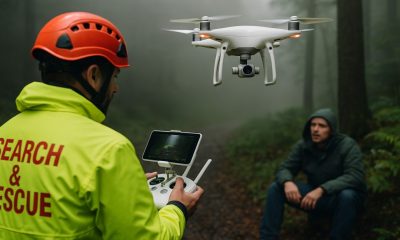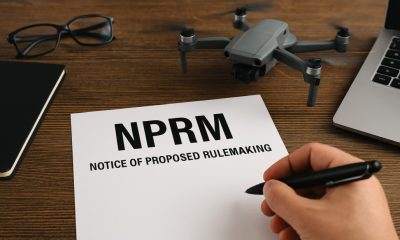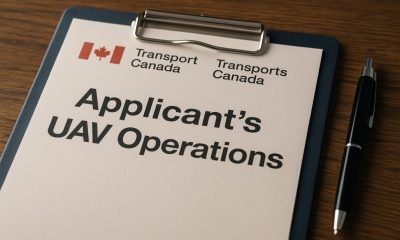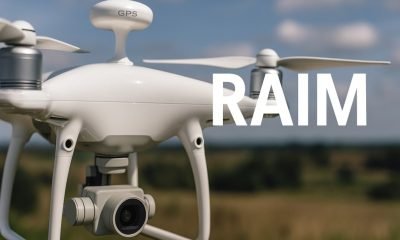- Acronym Guide
- AAM
- ABS
- AC
- ACAS
- ADS-B
- AFAC
- AGL
- AI
- AIM
- ALS
- AM
- AMA
- ANSP
- APPI
- AUV
- AUVSI
- ARPAS-UK
- ASTM
- ATC
- BVLOS
- CAA
- CAAC
- CAB
- CASA
- CATT
- CBO
- CBR
- CBRN
- CDMA
- CDR
- CFR
- COA
- COMINT
- CORS
- COTP
- COTR
- CPTED
- CV
- C2
- DAA
- DEM
- DFI
- DFS
- DGCA
- DHS
- DOD
- DPA
- DPEs
- DRO
- DSM
- DSMX
- DSP
- DSSS
- DTM
- EASA
- EFT
- EO
- EOD
- EO/IR
- ELINT
- EMI
- ESC
- EVLOS
- eVTOLs
- FAA
- FCC
- FCS
- FHSS
- FICCI
- FLIR
- FOB
- FOV
- FPS
- FPV
- GBDAA
- GCP
- GCS
- GDPR
- GNSS
- GPS
- GSD
- GVC
- HDR
- HOGE
- IACRA
- ICAO
- ICS
- IMU
- INS
- IR
- ISA
- ISR
- ITU
- LAAMS
- LAANC
- LAATM
- LAI
- LBA
- LIDAR
- LOS
- LSALT
- MAC
- MAVLink
- MLIT
- MMS
- MSL
- MTOM
- NDAA
- NCSL
- NFZ
- NIST
- NMEA
- NOTAM
- NPA
- NPRM
- NTIA
- OEM
- OFDM
- OOP
- PASM
- PAV
- PCV
- PdM
- PEC
- PIC
- PID
- PIPL
- PLD
- PM
- PN
- PPK
- PPS
- PSM
- PWM
- UAM
- UAOP
- UAS
- UASTM
- UAV
- UCAVs
- UHD
- UHF
- USV
- UTM
- RAIM
- RCC
- RCS
- RFI
- ReOC
- RePL
- RMS
- ROI
- RPAS
- RPC
- RTH
- RTK
- SaR
- SAR
- SARP
- SBAS
- S.Bus
- SEDENA
- SfM
- SFOC
- SIGINT
- SLAM
- SMS
- SORA
- STTR
- sUAS
- TCAS
- TCCA
- TFR
- TIN
- TOF
- TP
- TPS
- TSA
- VHF
- VLOS
- VTOL
Drone Acronyms
What is LIDAR (Light Detection and Ranging) & How Does it work?
By
Jacob StonerTable Of Contents

Definition
LIDAR stands for Light Detection and Ranging. It is a remote sensing method that uses laser light to measure distances to the Earth’s surface, creating detailed 3D maps and models.
Relevance to the Industry
This technology is vital for industries requiring high-precision spatial data. It offers significant advantages over traditional survey methods, including faster data acquisition, higher accuracy, and the ability to penetrate vegetation. In drone operations, LIDAR enhances capabilities in terrain mapping, infrastructure inspection, and disaster management.
How Does LIDAR Work?
Light Detection and Ranging (LIDAR) is a remote sensing technology that uses laser light to measure distances and create detailed three-dimensional maps of the environment. Here’s a detailed explanation of how LIDAR works:
1. System Components
- Laser Source: Emits laser pulses towards the target. The laser can be solid-state, fiber, or other types depending on the application.
- Scanner and Optics: Directs the laser pulses and collects the reflected light. The scanner can be mechanical or solid-state, sweeping the laser beam across the area of interest.
- Photodetector: Detects the reflected laser pulses. This can be a photodiode or other sensitive light-detection device.
- GPS and IMU: The Global Positioning System (GPS) and Inertial Measurement Unit (IMU) provide precise location and orientation data for the LIDAR sensor, crucial for accurate mapping.
2. Laser Pulse Emission and Reflection
- Pulse Emission: The laser source emits short pulses of light, typically in the near-infrared spectrum. These pulses are directed towards the target area.
- Pulse Reflection: When the laser pulses hit an object, they reflect back towards the LIDAR sensor. The time it takes for the pulses to return is measured.
3. Distance Measurement
- Time of Flight: The LIDAR system calculates the distance to the target by measuring the time it takes for the laser pulse to travel to the object and back. Since the speed of light is constant, this time can be converted into a distance.
- Multiple Returns: Some LIDAR systems can detect multiple reflections from a single pulse, capturing information about different layers, such as vegetation and ground level.
4. Point Cloud Generation
- Data Collection: The LIDAR system collects thousands to millions of distance measurements per second, generating a dense set of data points.
- Point Cloud: These data points form a “point cloud,” a 3D representation of the scanned environment. Each point in the cloud has coordinates (x, y, z) corresponding to the measured distance and the sensor’s position.
5. GPS and IMU Integration
- Position Data: The GPS provides the exact location of the LIDAR sensor, while the IMU provides orientation data (roll, pitch, yaw).
- Georeferencing: The point cloud data is georeferenced using the GPS and IMU data, ensuring that each point has accurate spatial coordinates relative to the Earth’s surface.
6. Data Processing and Analysis
- Noise Filtering: Raw LIDAR data can contain noise, which is filtered out during the processing phase.
- Classification: Points in the point cloud can be classified into different categories, such as ground, vegetation, buildings, and other structures.
- Model Creation: The processed point cloud can be used to create detailed 3D models and maps, useful for various applications like terrain modeling, urban planning, and infrastructure assessment.
7. Applications and Use Cases
- Topographic Mapping: Creating detailed maps of the Earth’s surface for geological, environmental, and planning purposes.
- Urban Planning and Development: Mapping urban areas to aid in city planning, infrastructure development, and construction.
- Forestry and Agriculture: Monitoring vegetation health, estimating biomass, and managing agricultural fields.
- Autonomous Vehicles: Providing real-time 3D perception for navigation and obstacle avoidance in self-driving cars.
- Archaeology: Discovering and mapping ancient structures hidden beneath vegetation or soil.
- Disaster Management: Assessing damage and creating accurate models for planning disaster response and recovery.
Understanding how LIDAR works showcases its versatility and the intricate technology behind it. This remote sensing method provides unparalleled detail and accuracy, making it invaluable in a wide range of scientific, industrial, and commercial applications.
Example in Use
“Using LIDAR-equipped drones, the construction company was able to create detailed topographic maps of the project site quickly and accurately.”
Frequently Asked Questions about LIDAR (Light Detection and Ranging)
1. What is LIDAR and how does it work?
Answer: LIDAR is a remote sensing technology that uses laser pulses to measure distances. It works by emitting laser beams towards a target and measuring the time it takes for the reflected light to return to the sensor. The distance to the target is calculated using the speed of light. This process creates a dense collection of spatial data points, known as a point cloud, which can be used to generate detailed 3D models and maps.
2. Why is LIDAR important for drones?
Answer: LIDAR is important for drones because it:
- Provides High-Precision Data: Captures accurate spatial measurements, crucial for mapping and surveying.
- Penetrates Vegetation: Can measure ground surfaces even through dense foliage, making it ideal for forestry and environmental studies.
- Enables 3D Modeling: Creates detailed 3D models of terrain, buildings, and other structures, aiding in urban planning and construction.
- Enhances Efficiency: Collects data rapidly over large areas, reducing time and labor costs compared to traditional surveying methods.
3. What are the applications of LIDAR in drone operations?
Answer: Applications include:
- Topographic Mapping: Creating detailed maps of the Earth’s surface for geological studies, infrastructure projects, and land management.
- Forestry: Assessing forest structure, biomass, and health by penetrating the canopy and mapping the terrain below.
- Agriculture: Monitoring crop health, planning irrigation, and managing fields with high precision.
- Urban Planning: Surveying urban environments, planning construction projects, and managing city infrastructure.
- Disaster Management: Assessing areas affected by natural disasters, such as floods and landslides, to aid in response and recovery efforts.
For examples of these acronyms visit our Industries page.
As the CEO of Flyeye.io, Jacob Stoner spearheads the company's operations with his extensive expertise in the drone industry. He is a licensed commercial drone operator in Canada, where he frequently conducts drone inspections. Jacob is a highly respected figure within his local drone community, where he indulges his passion for videography during his leisure time. Above all, Jacob's keen interest lies in the potential societal impact of drone technology advancements.











